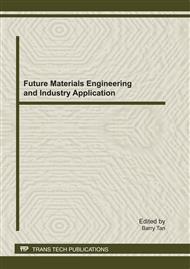[1]
Horii Y, Reiner JL, Loganathan BG, Kumar KS, Sajwan K, Kannan K: Occurrence and fate of polycyclic musks in wastewater treatment plants in Kentucky and Georgia, USA. Chemosphere 2007, 68(11): 2011-(2020).
DOI: 10.1016/j.chemosphere.2007.04.054
Google Scholar
[2]
Garcia-Jares C, Llompart M, Polo M, Salgado C, Macias S, Cela R: Optimisation of a solid-phase microextraction method for synthetic musk compounds in water. Journal of Chromatography A 2002, Vol. 963, no. (1-2), pp.277-285.
DOI: 10.1016/s0021-9673(02)00649-0
Google Scholar
[3]
Fromme, H., T. Otto, et al. (2001). Polycyclic musk fragrances in different environmental compartments in Berlin (Germany)., Water research 35(1): 121-128.
DOI: 10.1016/s0043-1354(00)00233-5
Google Scholar
[4]
Shek WM, Murphy MB, Lam JCW, Lam PKS: Synthetic polycyclic musks in Hong Kong sewage sludge. Chemosphere 2008, 71(7): 1241-1250.
DOI: 10.1016/j.chemosphere.2007.11.069
Google Scholar
[5]
Yang JJ, Metcalfe CD: Fate of synthetic musks in a domestic wastewater treatment plant and in an agricultural field amended with biosolids. Science of the Total Environment 2006, 363(1-3): 149-165.
DOI: 10.1016/j.scitotenv.2005.06.022
Google Scholar
[6]
Peck AM, Hornbuckle KC: Synthetic musk fragrances in urban and rural air of Iowa and the Great Lakes. Atmospheric Environment 2006, 40(32): 6101-6111.
DOI: 10.1016/j.atmosenv.2006.05.058
Google Scholar
[7]
Nakata H: Occurrence of synthetic musk fragrances in marine mammals and sharks from Japanese coastal waters. Environmental Science & Technology 2005, 39(10): 3430-3434.
DOI: 10.1021/es050199l
Google Scholar
[8]
Kannan K, Reiner JL, Yun SH, Perrotta EE, Tao L, Johnson-Restrepo B, Rodan BD: Polycyclic musk compounds in higher trophic level aquatic organisms and humans from the United States. Chemosphere 2005, 61(5): 693-700.
DOI: 10.1016/j.chemosphere.2005.03.041
Google Scholar
[9]
Muller J, Bohmer W, Litz NT: Occurrence of polycyclic musks in sewage sludge and their behaviour in soils and plants. Journal of Soils and Sediments 2006, 6(4): 231-235.
DOI: 10.1065/jss2006.10.187.1
Google Scholar
[10]
An J, Zhou QX, Sun YB, Xu ZQ: Ecotoxicological effects of typical personal care products on seed germination and seedling development of wheat (Triticum aestivum L. ). Chemosphere 2009, 76(10): 1428-1434.
DOI: 10.1016/j.chemosphere.2009.06.004
Google Scholar
[11]
Nakamori T, Fujimori A, Kinoshita K, Ban-nai T, Kubota Y, Yoshida S: mRNA expression of a cadmium-responsive gene is a sensitive biomarker of cadmium exposure in the soil collembolan Folsomia candida. Environmental Pollution 2010, 158(5): 1689-1695.
DOI: 10.1016/j.envpol.2009.11.022
Google Scholar
[12]
Brulle F, Morgan AJ, Cocquerelle C, Vandenbulcke F: Transcriptomic underpinning of toxicant-mediated physiological function alterations in three terrestrial invertebrate taxa: A review. Environmental Pollution 2010, 158(9): 2793-2808.
DOI: 10.1016/j.envpol.2010.06.019
Google Scholar
[13]
Rao JV, Kavitha P: Toxicity of azodrin on the morphology and acetylcholinesterase activity of the earthworm Eisenia foetida. Environmental Research 2004, 96(3): 323-327.
DOI: 10.1016/j.envres.2004.02.014
Google Scholar
[14]
Brulle F, Mitta G, Cocquerelle C, Vieau D, Lemiere S, Lepretre A, vandenBulcke F: Cloning and real-time PCR testing of 14 potential biomarkers in Eisenia fetida following cadmium exposure. Environmental Science & Technology 2006, 40(8): 2844-2850.
DOI: 10.1021/es052299x
Google Scholar
[15]
Asensio V, Kille P, Morgan AJ, Soto M, Marigomez I: Metallothionein expression and Neutral Red uptake as biomarkers of metal exposure and effect in Eisenia fetida and Lumbricus terrestris exposed to Cd. European Journal of Soil Biology 2007, 43: S233-S238.
DOI: 10.1016/j.ejsobi.2007.08.022
Google Scholar
[16]
Zheng SL, Song YF, Qiu XY, Sun TH, Ackland ML, Zhang W: Annetocin and TCTP expressions in the earthworm Eisenia fetida exposed to PAHs in artificial soil. Ecotoxicology and Environmental Safety 2008, 71(2): 566-573.
DOI: 10.1016/j.ecoenv.2007.10.025
Google Scholar
[17]
OECD (1984). Earthworm, acute toxicity tests, Guideline for testing chemicals. No. 207. OECD, Paris, France.
Google Scholar
[18]
Bradford, M. (1976). A rapid and sensitive method for the quantitation of microgram quantities of protein utilizing the principle of protein-dye binding., Analytical biochemistry 72(1-2): 248-254.
DOI: 10.1016/0003-2697(76)90527-3
Google Scholar
[19]
Ohkawa, H., N. Ohishi, et al. (1979). Assay for lipid peroxides in animal tissues by thiobarbituric acid reaction., Analytical biochemistry 95(2): 351-358.
DOI: 10.1016/0003-2697(79)90738-3
Google Scholar
[20]
Quiros L, Pina B, Solee M, Blasco J, Lopez MA, Riva MC, Barcelo D, Raldua D: Environmental monitoring by gene expression biomarkers in Barbus graellsii: Laboratory and field studies. Chemosphere 2007, 67(6): 1144-1154.
DOI: 10.1016/j.chemosphere.2006.11.032
Google Scholar
[21]
Lin D S, Zhou Q X, Xie X J, Liu Y. Potential biochemical and genetic toxicity of triclosan as an emerging pollutant on earthworms (Eisenia fetida), Chemosphere, 2010, Vol. 81, No. 10, pp.1328-33.
DOI: 10.1016/j.chemosphere.2010.08.027
Google Scholar
[22]
Xue YG, Gu XY, Wang XR, Sun C, Xu XH, Sun J, Zhang BG: The hydroxyl radical generation and oxidative stress for the earthworm Eisenia fetida exposed to tetrabromobisphenol A. Ecotoxicology 2009, 18(6): 693-699.
DOI: 10.1007/s10646-009-0333-2
Google Scholar
[23]
Dalton T P, Shertzer H G, Puga A, 1999. Regulation of gene expression by reactive oxygen. Annu. Rev. Pharmacol. Toxicol., 39, 67-101.
DOI: 10.1146/annurev.pharmtox.39.1.67
Google Scholar
[24]
Bigot, A., P. Vasseur, et al. (2010). SOD and CAT cDNA cloning, and expression pattern of detoxification genes in the freshwater bivalve Unio tumidus transplanted into the Moselle river., Ecotoxicology 19(2): 369-376.
DOI: 10.1007/s10646-009-0419-x
Google Scholar
[25]
Jo, P.G., Choi, Y.K., Choi, C.Y., 2008. Cloning and mRNA expression of antioxidant enzymes in the Pacific oyster, Crassostrea gigas in response to cadmium exposure. Comparative Biochemistry and Physiology C-Toxicology & Pharmacology 147, 460-469.
DOI: 10.1016/j.cbpc.2008.02.001
Google Scholar


